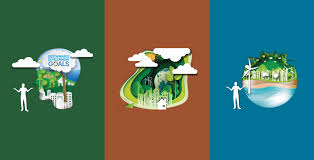The Intersection of Economic Growth and Sustainability
In recent years, the discourse around economic growth has increasingly focused on the concept of sustainability. While economic growth is traditionally measured by increases in GDP and productivity, sustainability emphasises the long-term viability of such growth without compromising future generations’ ability to meet their own needs.
One of the key challenges facing policymakers and businesses today is finding ways to achieve economic growth while also promoting sustainability. This requires a shift towards more environmentally friendly practices, resource efficiency, and social responsibility.
The Benefits of Sustainable Economic Growth
Sustainable economic growth offers a range of benefits that go beyond short-term gains. By investing in renewable energy sources, reducing waste, and promoting sustainable practices, businesses can lower their operational costs, enhance their reputation, and attract environmentally conscious consumers.
From a broader perspective, sustainable economic growth helps to preserve natural resources, mitigate climate change, and improve overall quality of life. By prioritising sustainability in economic development strategies, countries can create a more resilient and equitable society for current and future generations.
Challenges and Opportunities
Despite the clear benefits of sustainable economic growth, there are challenges that need to be addressed. Transitioning towards more sustainable practices may require upfront investments and changes in business models that could be perceived as risky or costly.
However, these challenges also present opportunities for innovation and creativity. Businesses that embrace sustainability can gain a competitive edge by tapping into new markets, attracting top talent, and fostering a culture of responsible corporate citizenship.
Conclusion
Economic growth and sustainability are not mutually exclusive goals; rather, they are interdependent pillars of a prosperous future. By integrating sustainability into economic policies and business strategies, we can create a more inclusive and resilient economy that benefits both people and the planet.
Exploring the Intersection of Economic Growth and Sustainability: Key Questions Answered
- Why does economic growth need to be sustainable?
- Can you have economic growth and sustainability?
- What is the economic impact of sustainability?
- What is economic growth and sustainability?
- How do you balance economic growth and sustainability?
- What is an example of sustainable economic growth?
Why does economic growth need to be sustainable?
Ensuring that economic growth is sustainable is crucial for several reasons. Sustainable economic growth takes into account the long-term impact of current practices on the environment, society, and future generations. By promoting sustainability, we can avoid depleting natural resources, causing irreversible damage to ecosystems, and exacerbating social inequalities. Sustainable economic growth also helps to build resilience against environmental challenges such as climate change and ensures that prosperity is not achieved at the expense of future generations’ well-being. Ultimately, integrating sustainability into economic growth strategies is essential for creating a more stable, equitable, and prosperous future for all.
Can you have economic growth and sustainability?
The question of whether economic growth and sustainability can coexist is a complex and nuanced one. While traditional models of economic growth have often been associated with environmental degradation and resource depletion, there is a growing recognition that sustainable practices can be integrated into economic development strategies. By prioritising renewable energy sources, promoting resource efficiency, and embracing social responsibility, it is possible to achieve economic growth that is both environmentally sound and socially equitable. Ultimately, the key lies in redefining our understanding of prosperity to encompass not just short-term gains but also long-term viability for future generations.
What is the economic impact of sustainability?
The economic impact of sustainability is a topic of significant interest and debate among policymakers, businesses, and scholars. Embracing sustainable practices can have both short-term costs and long-term benefits for economies. While initial investments in sustainability measures may require financial resources, the potential returns include reduced operational costs, improved resource efficiency, enhanced brand reputation, and access to new markets. Over time, integrating sustainability into economic strategies can contribute to long-term economic growth by fostering innovation, resilience, and competitiveness. Ultimately, the economic impact of sustainability extends beyond financial gains to encompass social well-being and environmental stewardship for a more sustainable future.
What is economic growth and sustainability?
Economic growth refers to the increase in a country’s production of goods and services over time, typically measured by indicators such as GDP. On the other hand, sustainability involves meeting current needs without compromising the ability of future generations to meet their own needs. In essence, economic growth and sustainability are intertwined concepts that seek to balance prosperity with environmental protection and social equity. Achieving sustainable economic growth requires a holistic approach that considers the long-term impact of economic activities on the environment, society, and economy. It involves promoting resource efficiency, reducing carbon emissions, and fostering inclusive development that benefits present and future generations.
How do you balance economic growth and sustainability?
Balancing economic growth and sustainability requires a strategic approach that considers the long-term implications of economic activities on the environment and society. It involves adopting policies and practices that promote economic development while minimising negative impacts on natural resources, ecosystems, and communities. By integrating sustainability principles into decision-making processes, such as investing in renewable energy, promoting circular economy practices, and implementing green technologies, it is possible to achieve a harmonious balance between economic growth and environmental stewardship. This proactive approach ensures that current needs are met without compromising the ability of future generations to meet their own needs, ultimately leading to a more resilient and sustainable economy.
What is an example of sustainable economic growth?
An example of sustainable economic growth can be seen in the development of a city’s public transportation system that prioritises renewable energy sources and promotes efficient use of resources. By investing in electric buses, bike-sharing programmes, and infrastructure for pedestrians, the city not only reduces carbon emissions but also improves air quality and enhances mobility for its residents. This approach to sustainable economic growth not only stimulates job creation in the green technology sector but also fosters a healthier and more liveable urban environment for both current and future generations.
